When I walked into my grandmother’s nature-inspired living room, I felt calm. The cozy space was filled with natural materials and sustainable decor. It showed her love for the earth.
I’m excited to share 7 budget-friendly DIY projects with you. These projects can make your space feel like my grandmother’s. They use natural elements and are easy on your wallet and the planet.
With these simple DIY projects, you can make your home feel warm and serene. Just like the outdoors, but in your beautiful living space.
Understanding Earthy Home Decor Trends
Exploring earthy home decor is exciting. It connects our homes to nature. This style celebrates the beauty of the outdoors, bringing it inside.
Embracing Natural Materials
Natural materials are key in earthy decor. Think wood, stone, clay, and plants. They add texture and depth, making spaces cozy and organic.
For example, reclaimed wood furniture or a stone vase can be stunning in any room.
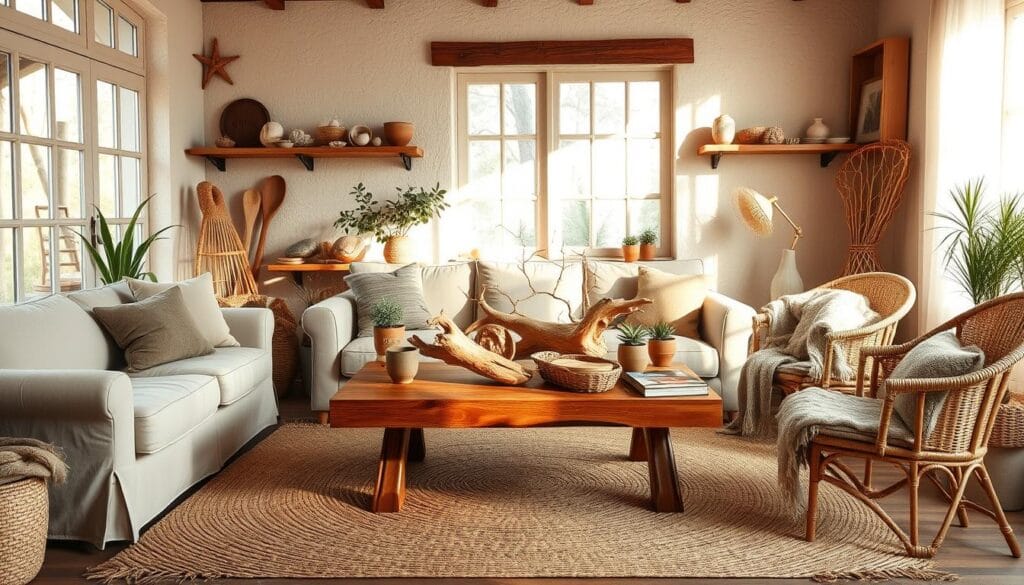
The Color Palette of Earthy Decor
The color palette is crucial in earthy decor. Earth tones like terracotta, sage green, sandy beige, and mossy hues are common. These colors are calming, bringing serenity to your home.
You can use these shades in paint, furniture, or accessories for a unified look.
- Terracotta and earthy reds for a warm, inviting atmosphere
- Sage greens and mossy tones for a calming, natural ambiance
- Sandy beiges and soft browns for a neutral, grounding effect
Benefits of an Earthy Aesthetic
An earthy aesthetic in your home decor has many benefits. It supports a sustainable lifestyle by using natural, recycled, and eco-friendly materials. The calming colors and natural textures also improve your well-being, creating a peaceful environment.
By adding earthy elements, you’re not just decorating. You’re creating a sanctuary that nourishes you and the planet.
DIY Project 1: Macramé Wall Hanging
Macramé wall hangings bring a natural, earthy vibe to your home. This DIY home decor project is easy on the wallet. It also lets you add a personal touch to your space.
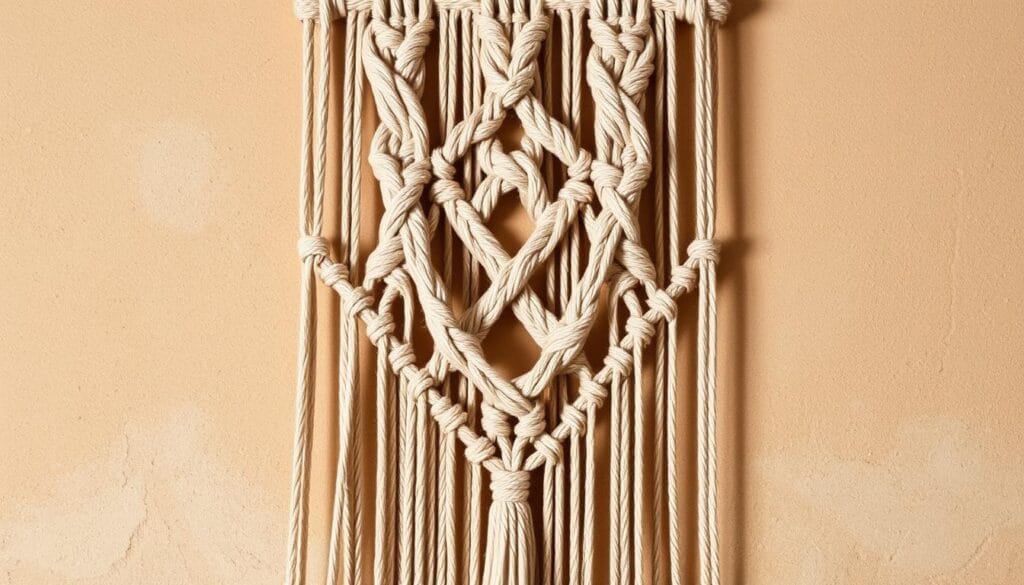
Materials Needed
To start, you’ll need a few simple items. Here’s what you’ll need for your macramé wall hanging:
- Cotton rope or macramé cord
- Wooden dowel or rod
- Scissors
- Board or other stable surface for knotting
- Measuring tape or ruler
- Optional: beads or other decorative elements
Step-by-Step Instructions
Making a macramé wall hanging is fun and rewarding. Here’s a step-by-step guide to help you start:
- Cut four pieces of cotton rope, each 2-3 yards long, depending on your desired hanging length.
- Fold the pieces in half and tie a knot at the top, securing them to the dowel.
- Start a series of knots, like the Lark’s Head knot, followed by square knots.
- Adjust the tension as you work to keep your hanging even and appealing.
- When you’ve reached the desired length, tie off the ends with a final knot.
Tips for Personalization
To make your macramé wall hanging unique, add personal touches. You can experiment with different knot patterns or add beads and other decorations. DIY projects are all about customizing, so don’t hesitate to try new things and make it your own!
By following these steps and tips, you’ll create a beautiful eco-friendly home accessory. It will add a handmade charm to your space.
DIY Project 2: Reclaimed Wood Shelves
Building reclaimed wood shelves is a fun DIY project. It adds warmth to any room. Plus, it supports sustainable interior styling by using materials that would be wasted.
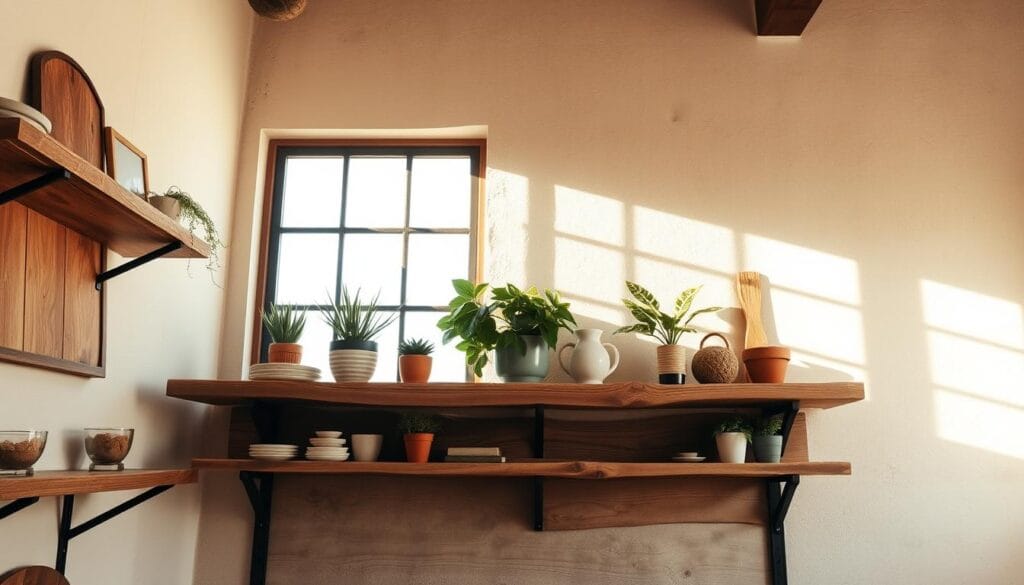
Choosing the Right Wood
Choosing the right wood is key for your shelves. Look for wood from old barns, pallets, or fencing. This makes your shelves unique and supports organic home furnishings.
- Find wood with interesting textures or markings.
- Make sure the wood can hold the weight of your items.
- Choose wood that matches your decor in color and grain.
Construction Steps
Building your shelves involves a few steps:
- Measure and cut the wood to size.
- Sand the wood to smooth out edges.
- Use brackets or a design to assemble the shelves.
- Attach the shelves to the wall to prevent them from tipping.
By following these steps, you can make reclaimed wood shelves that are both functional and beautiful.
Styling Your Shelves
After building your shelves, it’s time to style them. Here are some tips:
- Mix decorative items with everyday objects.
- Use different heights and textures for interest.
- Keep the arrangement balanced but not too symmetrical.
Styling your shelves is about showing your taste while keeping a cohesive look. This ties in with your sustainable interior styling efforts.
DIY Project 3: Terrariums and Indoor Plants
Bringing the outdoors in can make your home look better. Creating terrariums and adding indoor plants is a simple way to do this. It adds natural beauty and makes your space feel calm.
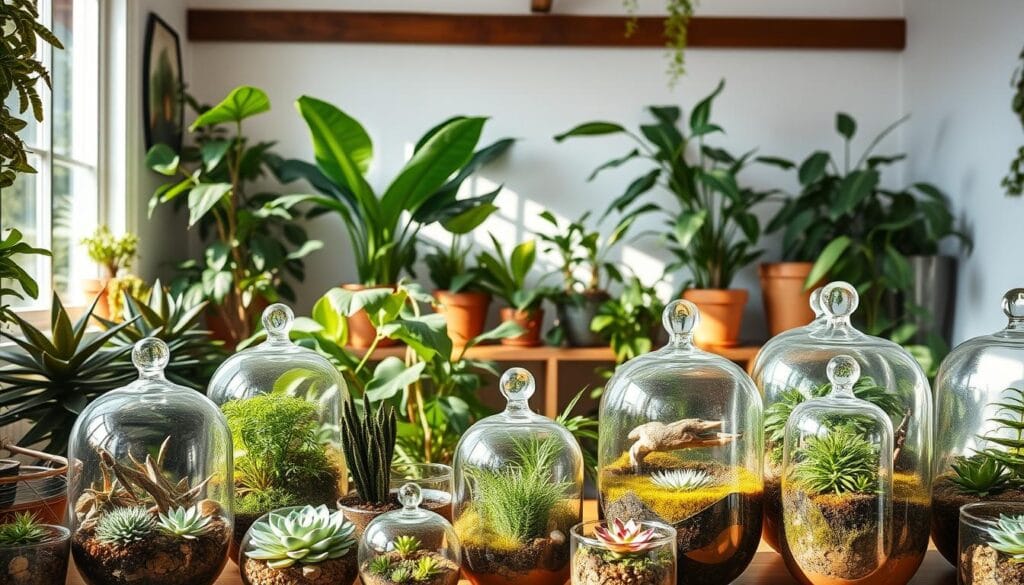
Selecting the Right Plants
Choosing the right plants for terrariums or indoor spaces is key. Look for plants that do well in low light and need similar water. Good choices include:
- Succulents and cacti for a desert look
- Ferns and mosses for a lush, tropical vibe
- Air plants for a unique display
For more ideas on using plants in your decor, check out https://homedecorwoodworking.com/home-decor-ideas-diy/. It has lots of DIY home decor ideas.
Building a Terrarium
Making a terrarium is a fun DIY project. You’ll need a few basic things:
- A clear glass container (like a jar or vase)
- Small plants of your choice
- Soil made for terrariums or low-draining mixes
- Decorative rocks or pebbles
- Optional: activated charcoal, moss, or other decorations
Start by adding small rocks or pebbles at the bottom for drainage. Then, add a layer of activated charcoal (if using) to stop mold. Fill it about 1/3 to 1/2 with soil, then plant your plants. Finish with decorative touches like moss or small stones.
Maintenance Tips
Keeping terrariums and indoor plants low-maintenance is a big plus. To keep them healthy, remember to:
- Water sparingly to avoid overwatering
- Place them in bright, indirect light, not direct sunlight
- Keep an eye on temperature and avoid vents
- Rotate them now and then for even growth
By following these easy steps and tips, you can enjoy the beauty of terrariums and indoor plants in your home. They enhance your decor with a touch of green living.
DIY Project 4: Stone and Pebble Décor
Using stone and pebble decor is a great way to add nature to your home. It’s calming to bring the outdoors inside. Stones and pebbles make it easy and fun.
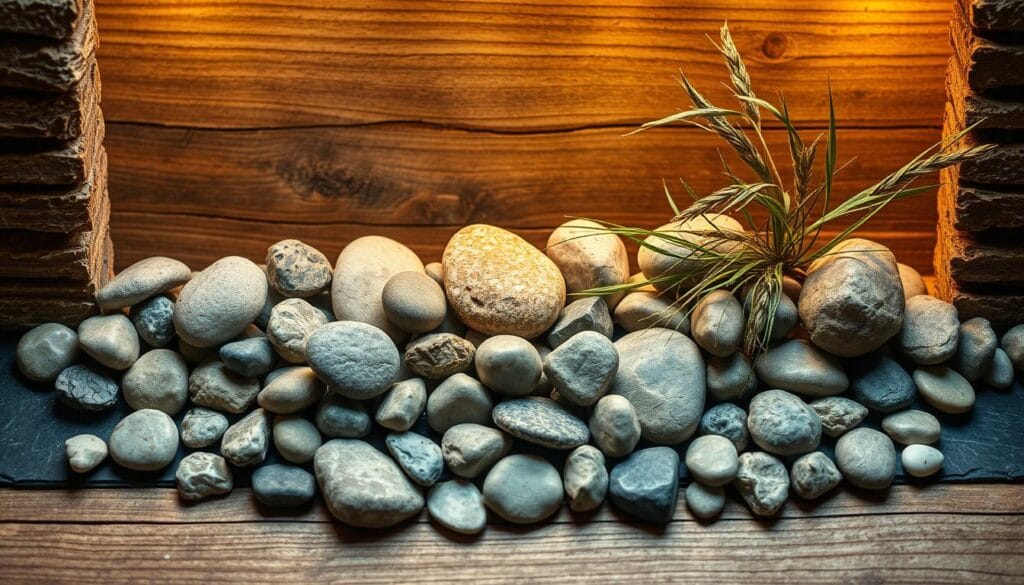
Finding Natural Stones
To begin your project, find the right materials. Look for stones and pebbles at beaches, parks, or your backyard. If that’s hard, try local craft stores or online.
For more ideas, check out garden border ideas with stone and pebble decor.
Crafting Decorative Pieces
Crafting with stones and pebbles is fun and creative. Here are a few ideas:
- Make a stunning centerpiece with stones and pebbles in a bowl.
- Use pebbles to frame your plants or garden beds.
- Glue stones onto a canvas or wooden panel for unique wall art.
Integrating into Your Space
After making your pieces, place them in your home. Put them in calm areas like bedrooms or meditation rooms. They also work well in living rooms or kitchens.
Remember to balance them with other decor. This way, your space won’t feel too busy.
Adding stone and pebble decor makes your home feel earthy and peaceful. So, get creative and enjoy making different projects!
DIY Project 5: Earthy Textiles
Earthy textiles like organic cotton and linen add depth and character to your home. They make your space look better and help the planet. This is because they are natural and sustainable.
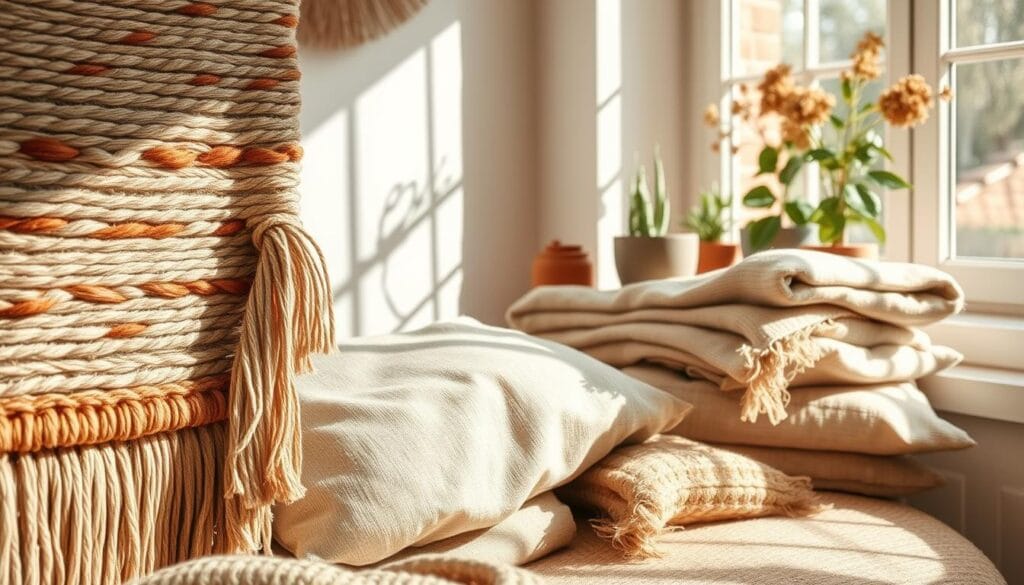
Choosing Fabrics
There are many fabrics to choose from for your project. Organic cotton, linen, and hemp are great. They are natural and good for the environment. They also add warmth and texture to your home.
Think about the colors of your fabrics. Choose earthy tones like beige, sage, and terracotta. These colors match well with nature.
How to Sew Simple Pillow Covers
Making simple pillow covers is a fun DIY project. Here’s how to do it:
- Measure your pillow to figure out how big your fabric should be.
- Cut two pieces of fabric to the right size, leaving room for seams.
- Put the fabric pieces together, right sides facing each other, and sew around the edges. Leave a small opening.
- Turn the cover right side out, put in the pillow, and sew the opening by hand.
This project is easy and fun. You can use different fabrics and add embellishments to make it your own.
Layering Textiles for Depth
Layering textiles adds depth and interest to a room. Start with a natural fiber rug. Then add throw blankets, pillows, and other items made from earthy materials.
Using different textures and patterns makes your space inviting. For example, a linen sofa with cotton pillows and a hemp rug looks great. It’s a layered, earthy look.
Using earthy textiles in your home makes it warm and welcoming. It feels connected to nature.
DIY Project 6: Driftwood Centerpieces
Driftwood is amazing for making centerpieces because of its unique shapes and textures. It’s not just beautiful; it’s also eco-friendly and sustainable. We’ll show you how to find driftwood, make beautiful centerpieces, and use them in your seasonal decor.
Sourcing Driftwood
Finding the right driftwood is the first step. I like to search beaches, rivers, and lakes for interesting pieces. If you can’t find driftwood in nature, you can buy it at craft stores or online. Make sure it’s dry and not damaged.
For more ideas on where to find driftwood, check out this guide on driftwood DIY ideas.
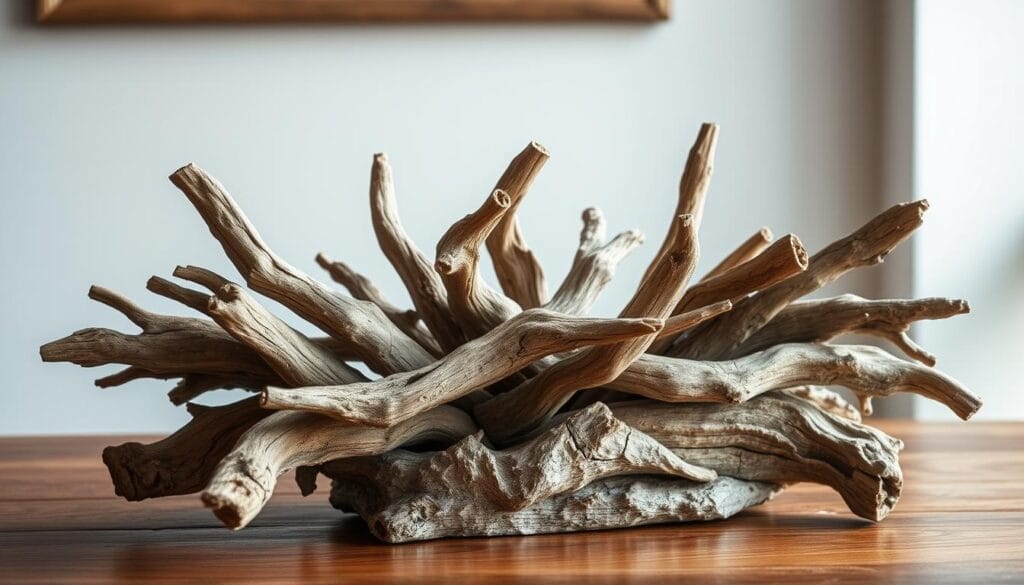
Assembly Techniques
Once you have your driftwood, it’s time to get creative. Here are a few ways to put your centerpieces together:
- Arrange the driftwood in a circular pattern and secure with a wire or a hot glue gun.
- Mix driftwood with other natural elements like candles, pebbles, or seashells for added texture.
- Use a base or a vase to stabilize your driftwood arrangement.
Try different shapes and sizes to make a unique centerpiece that shows your style.
Seasonal Decorations
Driftwood centerpieces can fit any season. For example, add seasonal flowers or foliage to your arrangement. In winter, mix it with evergreen branches, pinecones, and candles for a cozy feel. In summer, add seashells or starfish for a beachy look.
Using driftwood in your decor adds a beautiful, natural touch. It also supports eco-friendly home accessories that are good for the environment.
DIY Project 7: Homemade Botanical Prints
Homemade botanical prints bring nature into your home. It’s a fun and creative way to decorate. You can use leaves, flowers, and other plants to make your prints.
What You’ll Need
To start, gather these materials:
- Leaves, flowers, or other botanical specimens
- Paper (watercolor or thick printing paper works well)
- Ink or paint
- A rolling pin or brayer
- A frame for displaying your final print
Choosing the right materials is key. Use high-quality paper for lasting prints.
Printing Techniques
There are many ways to make botanical prints. One method is to coat your specimen with ink or paint, then press it onto paper. You can also try:
- Nature printing, where you directly press the specimen onto the paper
- Gelly plate printing, which involves using a gelly plate to create unique, textured prints
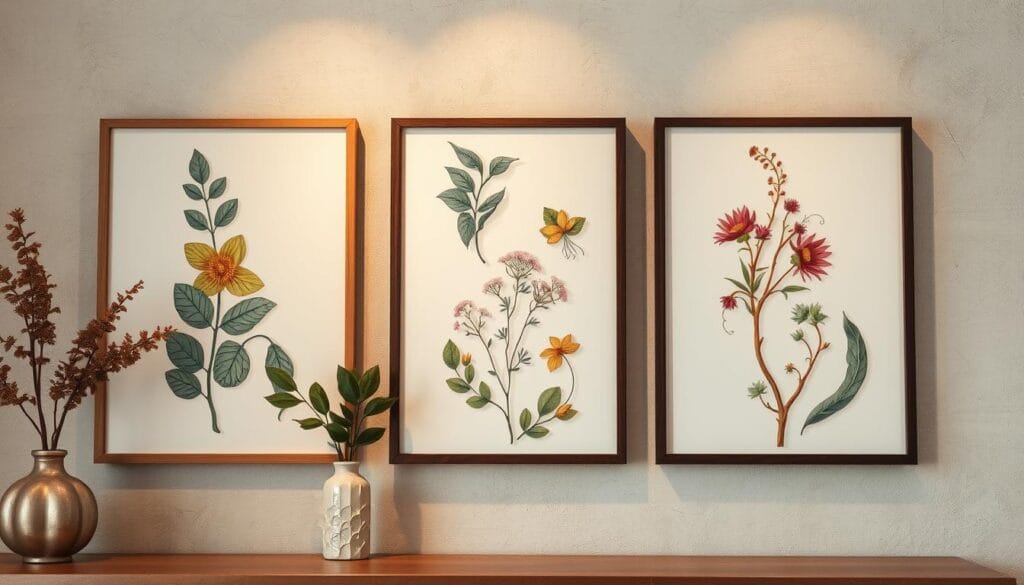
Trying different techniques will help you get the look you want for your nature-inspired home design.
Displaying Your Artwork
After making your prints, it’s time to show them off. You can frame them alone or together. Use eco-friendly frames to keep the natural theme. Hang them in a bright room to make them pop.
Displaying your prints adds beauty and starts interesting conversations with guests.
Incorporating Earthy Accessories Into Your Home
To complete your earthy home decor, think about adding natural elements and textures. Earthy accessories can make your space feel more welcoming and organic. By choosing and placing these elements carefully, you can create a cozy and inviting atmosphere.
Textures to Consider
Texture is key in earthy decor. Mixing different natural textures can make your space more interesting and deep. Here are some textures to think about:
- Wood: Reclaimed or sustainably sourced wood adds warmth and character.
- Stone: Marble, granite, or river rocks bring the outdoors inside.
- Woven fibers: Baskets, jute rugs, and other natural fibers add coziness and texture.
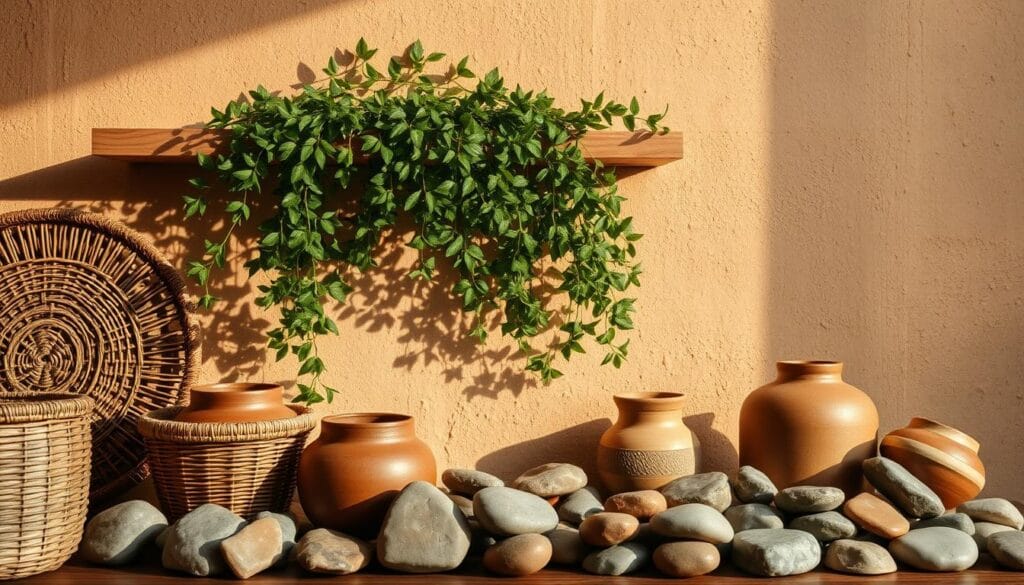
Choosing Earthy Color Accents
The right colors can make your earthy decor pop. Earthy tones like terracotta, sage green, and sandy beige bring warmth and peace. Use these colors in:
- Throw pillows and blankets: Natural fabrics in earthy tones add color and texture.
- Vases and decorative accents: Choose items that reflect nature, like ceramic vases or wooden decorations.
- Wall art: Natural elements or earth-toned prints can enhance your decor.
By adding these earthy accessories, focusing on natural textures, and choosing earthy colors, you can make your home feel connected to nature.
The Role of Lighting in Earthy Decor
Lighting is key to setting the mood in your earthy home decor. It’s not just about seeing; it’s about feeling the warmth and natural beauty of your space.
Types of Lighting Fixtures
Choosing the right lighting fixtures is crucial for an earthy look. Here are some great options:
- Table lamps made from natural materials like wood or stone add warmth and character.
- Pendant lights with earthy tones or natural fibers create a cozy feel.
- Floor lamps with wooden or rattan elements bring organic elegance to your rooms.
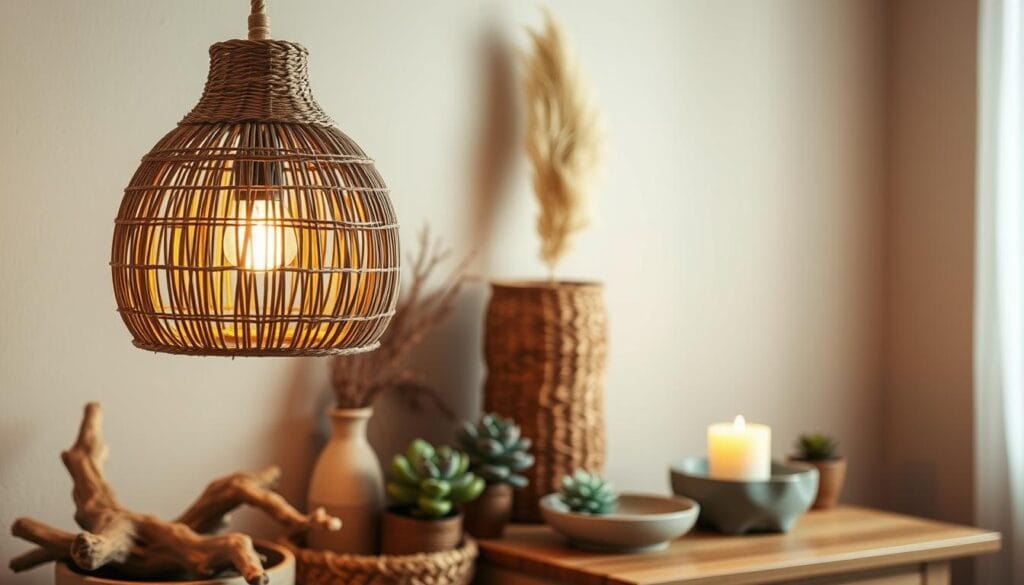
Creating Warm Ambiance
To create a warm ambiance, layer different light sources and pick the right bulbs. Here’s how:
- Use a mix of overhead lighting, table lamps, and floor lamps for a layered effect.
- Choose warm-toned light bulbs, like soft white or warm white, to enhance the earthy feel.
- Consider dimmers to adjust the lighting levels for different times or occasions.
By picking the right lighting fixtures and techniques, you can make your space warm and welcoming. It will perfectly match your earthy home decor.
Maintenance and Care for Earthy Decor
Keeping your earthy decor looking great is easy with a few simple steps. We’ve shared DIY projects to make your home earthy. Now, let’s talk about how to take care of these natural elements.
Cleaning Natural Materials
Wood, stone, and plants need special care. For wood, a dry cloth works best. If dirt is tough, use a damp cloth but dry it well to avoid damage.
- Stone decor can be cleaned with a mild soap solution. Stay away from harsh chemicals that can harm the stone.
- Plants need regular water and pruning. Make sure your pots drain well to prevent root rot.

Seasonal Upkeep Tips
Seasonal changes are a great time to update your earthy decor. Here are some tips:
- Spring: Give your plants a fresh start by repotting and pruning them.
- Summer: Enjoy the warm weather by airing out your textiles. Swap heavy drapes for lighter, natural ones.
- Autumn: Add autumn touches like pinecones or fallen leaves to your decor.
- Winter: Keep your plants safe from cold drafts. Use humidifiers to fight dry air.
By following these care tips, your earthy decor will last for years. Your home will stay warm and welcoming.
Budgeting for Earthy Decor Projects
Budgeting for earthy decor projects is simpler than you might think. I’m here to help you navigate it. Creating a beautiful, earthy space is all about watching your spending. Focus on finding affordable sources and tracking your costs to get the look you want without overspending.
Cost-Effective Sourcing
Earthy decor loves natural, easy-to-find materials. To save money, look for materials at:
- Local thrift stores for unique, repurposed items
- Nature walks for branches, stones, and other natural elements
- Discount stores or online marketplaces for affordable decor items
For more earthy home decor ideas on a budget, check out DIY home decor inspiration online.
Tracking Your Expenses
To keep within your budget, tracking your spending is key. Here are some tips:
- Create a spreadsheet to list all your decor projects and their costs
- Set a budget for each project and stick to it
- Regularly review your spending to ensure you’re on track
By watching your expenses and finding affordable materials, you can enjoy making your earthy home decor without worrying about money.
Final Thoughts on Earthy Home Decor
Exploring earthy home decor shows us how natural beauty and sustainability can change our homes. The seven DIY projects we’ve looked at are a great way to start. They help bring the outdoors into your living space.
Recap of Creative Projects
Projects like macramé wall hangings and homemade botanical prints show the beauty of earthy decor. These DIY projects are affordable and add a personal touch. They also help us live more sustainably by using materials in new ways and celebrating nature.
Long-Term Benefits of Earthy Decor
Choosing earthy decor brings many benefits. It connects us more to nature and reduces harm to the environment. Using natural materials and designs inspired by nature makes our homes feel more grounded and inspiring.
This style not only makes our homes look better but also improves our well-being and peace of mind.

Really insightful piece! Customer experience is everything these days, especially in competitive gaming. Seeing platforms like winph login prioritize support-from quick PH987 access to streamlined JiliPH assistance-is a huge step forward. It’s about more than just gameplay!
gp4zmy
Really insightful article! Building a solid foundation is key, especially for new players. I like how platforms like Pinas777 Slot Login prioritize that learning curve – smart design! Definitely helps avoid getting overwhelmed. Great read!
Roulette’s randomness is fascinating – the math really dictates outcomes! Seeing platforms like PH222 login free focus on seamless access & user experience is key for enjoying those odds. A smooth login is half the battle! 🤔
Nice post. I study something more challenging on totally different blogs everyday. It will at all times be stimulating to learn content from other writers and apply a bit something from their store. I’d prefer to use some with the content on my blog whether or not you don’t mind. Natually I’ll offer you a link on your internet blog. Thanks for sharing.
Thanks for your write-up. One other thing is individual states have their own laws which affect property owners, which makes it quite hard for the the nation’s lawmakers to come up with a fresh set of rules concerning foreclosures on householders. The problem is that every state has got own legal guidelines which may interact in an adverse manner on the subject of foreclosure insurance plans.
Lottery odds are fascinating, aren’t they? Seeing platforms like jlboss innovate with game variety & easy access-like that app!-makes things more engaging. Secure logins are key, too! It’s all about responsible fun.
I’ve been surfing online more than three hours today, yet I by no means found any fascinating article like yours. It is lovely price enough for me. In my opinion, if all webmasters and bloggers made excellent content as you did, the net will probably be much more useful than ever before.
Smart bankroll management is key, especially with so many new platforms like 68 win popping up. Localization, like they offer in Vietnam, can really boost player experience & trust! Play responsibly, folks.
Thanks for the ideas you discuss through your blog. In addition, quite a few young women who seem to become pregnant usually do not even make an effort to get health insurance coverage because they dread they probably would not qualify. Although many states currently require that insurers produce coverage despite the pre-existing conditions. Charges on these types of guaranteed options are usually bigger, but when considering the high cost of health care bills it may be a new safer strategy to use to protect your financial future.
That’s a solid point about team dynamics impacting betting! Seeing platforms like phlwin online casino cater specifically to Filipino players with easy GCash access is smart – accessibility matters! It’s all about enjoying the game, right?
RTP analysis is key to enjoying slots – finding fair games really enhances the experience! Seeing platforms like phlboss88 cater to Filipino players with diverse options (slots, fishing!) is great. Secure verification is a plus too!
Interesting analysis! Seeing a lot of new platforms like 33wim casino catering to specific regions is smart. Streamlined registration, as they highlight, is key for attracting players these days. Good insights here!
I’d also like to convey that most people who find themselves with out health insurance are typically students, self-employed and those that are jobless. More than half from the uninsured are really under the age of 35. They do not experience they are wanting health insurance because they’re young and healthy. Its income is normally spent on real estate, food, and also entertainment. Lots of people that do work either whole or as a hobby are not supplied insurance by their work so they get along without because of the rising cost of health insurance in the usa. Thanks for the tips you discuss through this web site.
Interesting read! Seeing tech really change how we approach games is exciting. The speed & security features at 999phl online casino, like biometric login, sound like a real step forward. It’s about enhancing the experience, not just adding bells & whistles!
Solid article! Thinking about bankroll management is key, especially with so many tempting slots like those on bossjl legit. Quick registration sounds great too – less time waiting, more time playing! 😉
We absolutely love your blog and find a lot of your post’s to be exactly what I’m looking for. Does one offer guest writers to write content to suit your needs? I wouldn’t mind composing a post or elaborating on some of the subjects you write with regards to here. Again, awesome web site!
Virtual sports betting blends strategy and chance beautifully. Platforms like SuperPH make it easier with smooth navigation and top-tier game providers. A great resource for both casual and serious bettors!
Thank you, I’ve just been looking for information about this topic for ages and yours is the greatest I’ve found out so far. However, what in regards to the bottom line? Are you positive in regards to the supply?
Smart bankroll management is key, especially with so many platforms now! Seeing seamless GCash integration on jl boss com is a definite plus for quick, secure play. Remember to gamble responsibly!
I have observed that car insurance organizations know the vehicles which are at risk from accidents along with risks. Additionally they know what style of cars are inclined to higher risk and also the higher risk they have got the higher the premium price. Understanding the simple basics connected with car insurance will assist you to choose the right sort of insurance policy that should take care of your needs in case you get involved in an accident. Many thanks sharing a ideas on your own blog.
I think other site proprietors should take this web site as an model, very clean and fantastic user friendly style and design, as well as the content. You’re an expert in this topic!
Hey this is somewhat of off topic but I was wanting to know if blogs use WYSIWYG editors or if you have to manually code with HTML. I’m starting a blog soon but have no coding know-how so I wanted to get guidance from someone with experience. Any help would be greatly appreciated!
http://www.mybudgetart.com.au is Australia’s Trusted Online Wall Art Canvas Prints Store. We are selling art online since 2008. We offer 1000+ artwork designs, up-to 50 OFF store-wide, Budget Pricing Wall Prints starts from $70, FREE Delivery Australia & New Zealand and World-wide shipping. Order Online your canvas prints today at mybudgetart.com.au
Normally I do not read article on blogs, however I would like to say that this write-up very compelled me to try and do so! Your writing taste has been surprised me. Thanks, quite great post.
Pretty great post. I simply stumbled upon your blog and wished to say that I’ve truly loved browsing your blog posts. In any case I will be subscribing for your rss feed and I am hoping you write again soon!
Thank you for another informative website. Where else may just I am getting that kind of information written in such a perfect way? I have a challenge that I’m simply now running on, and I have been at the look out for such info.
What I have constantly told men and women is that when searching for a good online electronics store, there are a few elements that you have to take into consideration. First and foremost, you want to make sure to locate a reputable and in addition, reliable retailer that has obtained great reviews and ratings from other buyers and marketplace professionals. This will ensure you are getting through with a well-known store that gives good assistance and aid to it’s patrons. Many thanks sharing your opinions on this website.
Thanks for the auspicious writeup. It in reality used to be a enjoyment account it. Glance complex to far brought agreeable from you! By the way, how can we keep up a correspondence?
Hi there are using WordPress for your site platform? I’m new to the blog world but I’m trying to get started and set up my own. Do you need any coding expertise to make your own blog? Any help would be greatly appreciated!
I’m blown away by the quality of this content! The author has undoubtedly put a great amount of effort into exploring and organizing the information. It’s refreshing to come across an article that not only offers useful information but also keeps the readers hooked from start to finish. Kudos to him for producing such a brilliant work!
Hi there, just became aware of your blog through Google, and found that it is really informative. I?m gonna watch out for brussels. I?ll be grateful if you continue this in future. Many people will be benefited from your writing. Cheers!
Aw, this was a very nice post. In idea I wish to put in writing like this moreover ? taking time and precise effort to make a very good article? however what can I say? I procrastinate alot and by no means appear to get one thing done.
Currently it looks like Movable Type is the best blogging platform out there right now. (from what I’ve read) Is that what you are using on your blog?
There are definitely quite a lot of details like that to take into consideration. That could be a great level to bring up. I supply the ideas above as general inspiration however clearly there are questions like the one you deliver up the place an important thing shall be working in trustworthy good faith. I don?t know if best practices have emerged round things like that, however I am certain that your job is clearly identified as a good game. Both boys and girls really feel the affect of only a second?s pleasure, for the remainder of their lives.
Hi there would you mind sharing which blog platform you’re working with? I’m going to start my own blog in the near future but I’m having a hard time selecting between BlogEngine/Wordpress/B2evolution and Drupal. The reason I ask is because your design and style seems different then most blogs and I’m looking for something unique. P.S Sorry for getting off-topic but I had to ask!
I?d must check with you here. Which isn’t something I normally do! I enjoy studying a put up that will make people think. Additionally, thanks for permitting me to comment!
Definitely imagine that which you stated. Your favorite reason appeared to be on the internet the easiest factor to understand of. I say to you, I certainly get annoyed while other folks think about worries that they just do not understand about. You managed to hit the nail upon the highest and defined out the entire thing without having side effect , people could take a signal. Will probably be again to get more. Thank you
After I originally commented I clicked the -Notify me when new feedback are added- checkbox and now every time a remark is added I get four emails with the same comment. Is there any means you’ll be able to take away me from that service? Thanks!
Hey just wanted to give you a quick heads up and let you know a few of the images aren’t loading properly. I’m not sure why but I think its a linking issue. I’ve tried it in two different web browsers and both show the same results.
I have observed that online diploma is getting well-known because accomplishing your college degree online has developed into a popular method for many people. A large number of people have definitely not had a possible opportunity to attend an established college or university however seek the raised earning potential and a better job that a Bachelors Degree gives you. Still other individuals might have a degree in one discipline but would want to pursue anything they now have an interest in.
An fascinating dialogue is price comment. I think that it’s best to write more on this topic, it won’t be a taboo topic however usually people are not enough to speak on such topics. To the next. Cheers
We’re a gaggle of volunteers and opening a brand new scheme in our community. Your site provided us with useful info to paintings on. You’ve done an impressive activity and our entire group might be thankful to you.
I have realized that over the course of making a relationship with real estate entrepreneurs, you’ll be able to come to understand that, in every real estate transaction, a fee is paid. All things considered, FSBO sellers don’t “save” the payment. Rather, they try to earn the commission by means of doing a great agent’s job. In doing so, they commit their money and also time to complete, as best they might, the tasks of an real estate agent. Those jobs include exposing the home via marketing, offering the home to buyers, constructing a sense of buyer urgency in order to make prompt an offer, booking home inspections, managing qualification investigations with the lender, supervising maintenance tasks, and aiding the closing.
Great goods from you, man. I’ve understand your stuff previous to and you’re just too great. I actually like what you’ve acquired here, really like what you are saying and the way in which you say it. You make it entertaining and you still care for to keep it wise. I cant wait to read much more from you. This is really a wonderful web site.
Thanks for your interesting article. One other problem is that mesothelioma is generally brought on by the breathing of materials from mesothelioma, which is a cancer causing material. It can be commonly noticed among individuals in the engineering industry who have long exposure to asbestos. It is caused by moving into asbestos protected buildings for a long period of time, Family genes plays an important role, and some consumers are more vulnerable on the risk as compared to others.
My brother recommended I might like this web site. He was entirely right. This post actually made my day. You can not imagine just how much time I had spent for this information! Thanks!
Good day! Do you know if they make any plugins to help with SEO? I’m trying to get my blog to rank for some targeted keywords but I’m not seeing very good results. If you know of any please share. Cheers!
I like what you guys are up also. Such clever work and reporting! Keep up the superb works guys I have incorporated you guys to my blogroll. I think it will improve the value of my web site 🙂
Hi there, You have done an incredible job. I will definitely digg it and individually suggest to my friends. I am sure they’ll be benefited from this site.